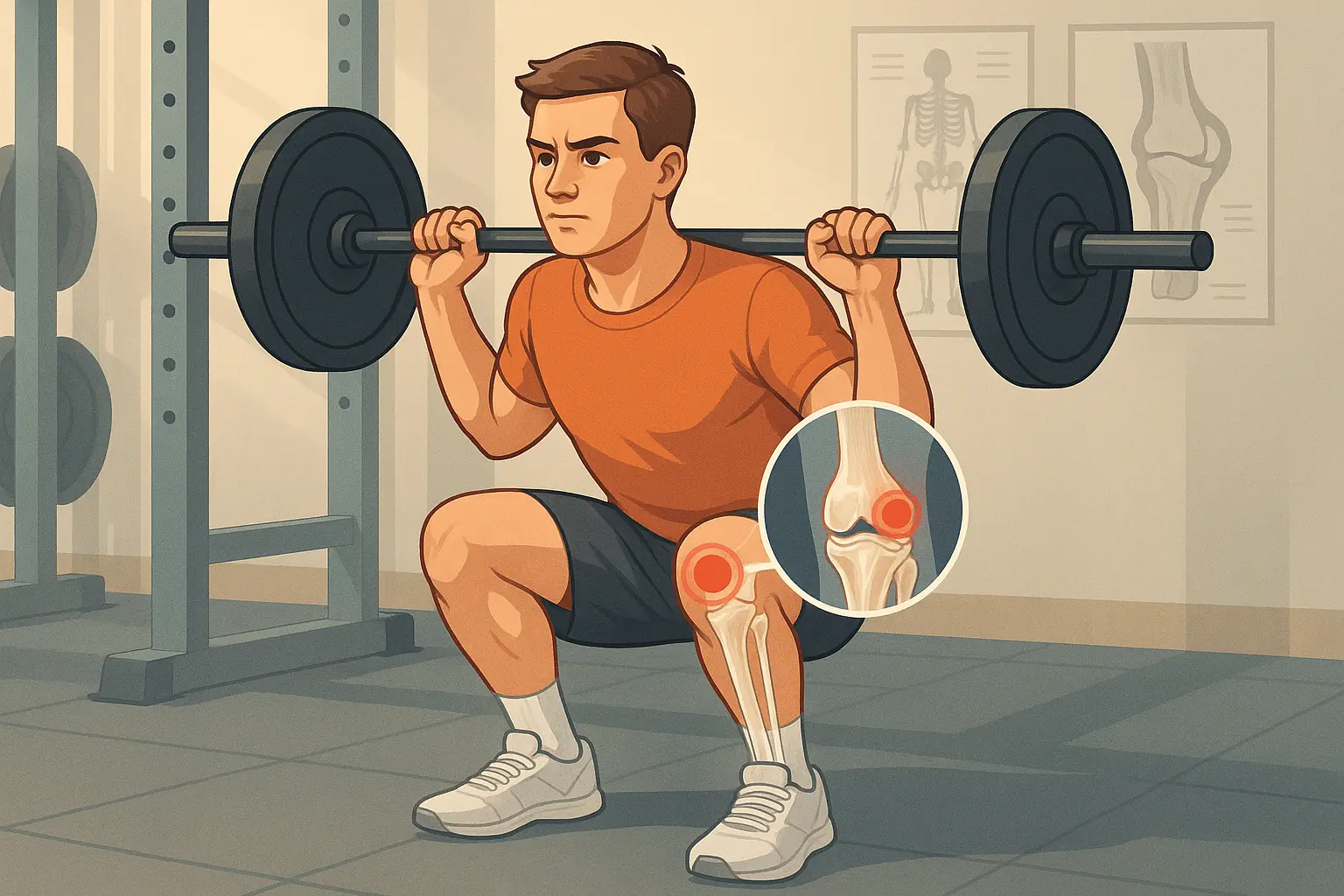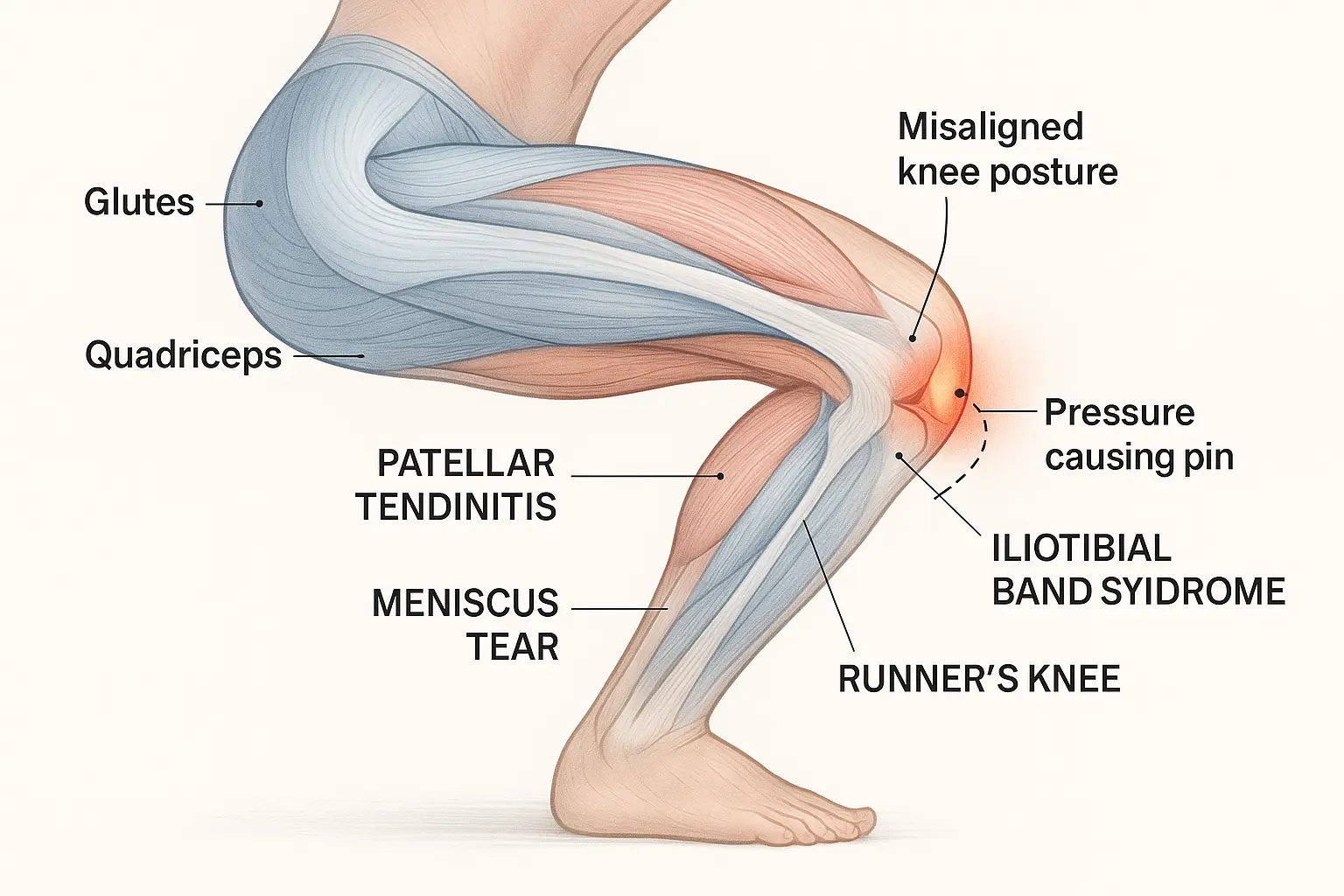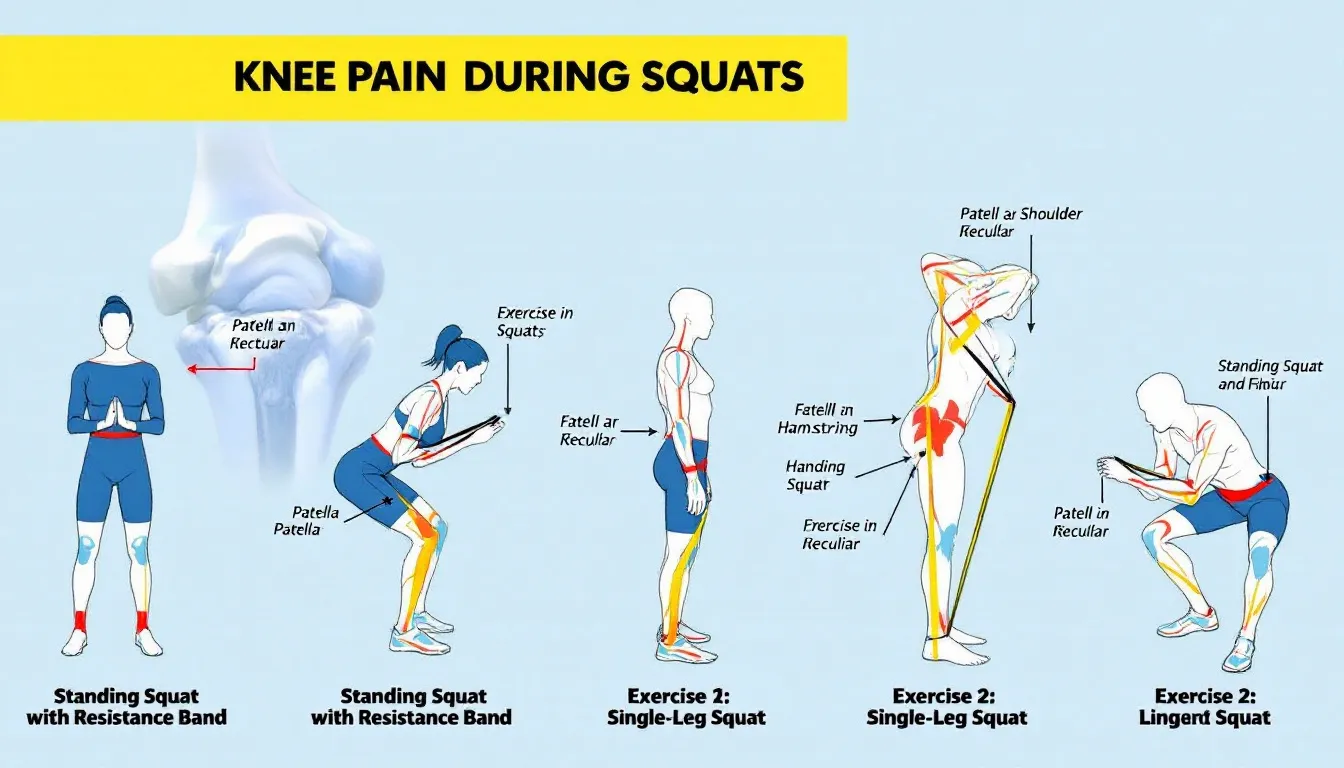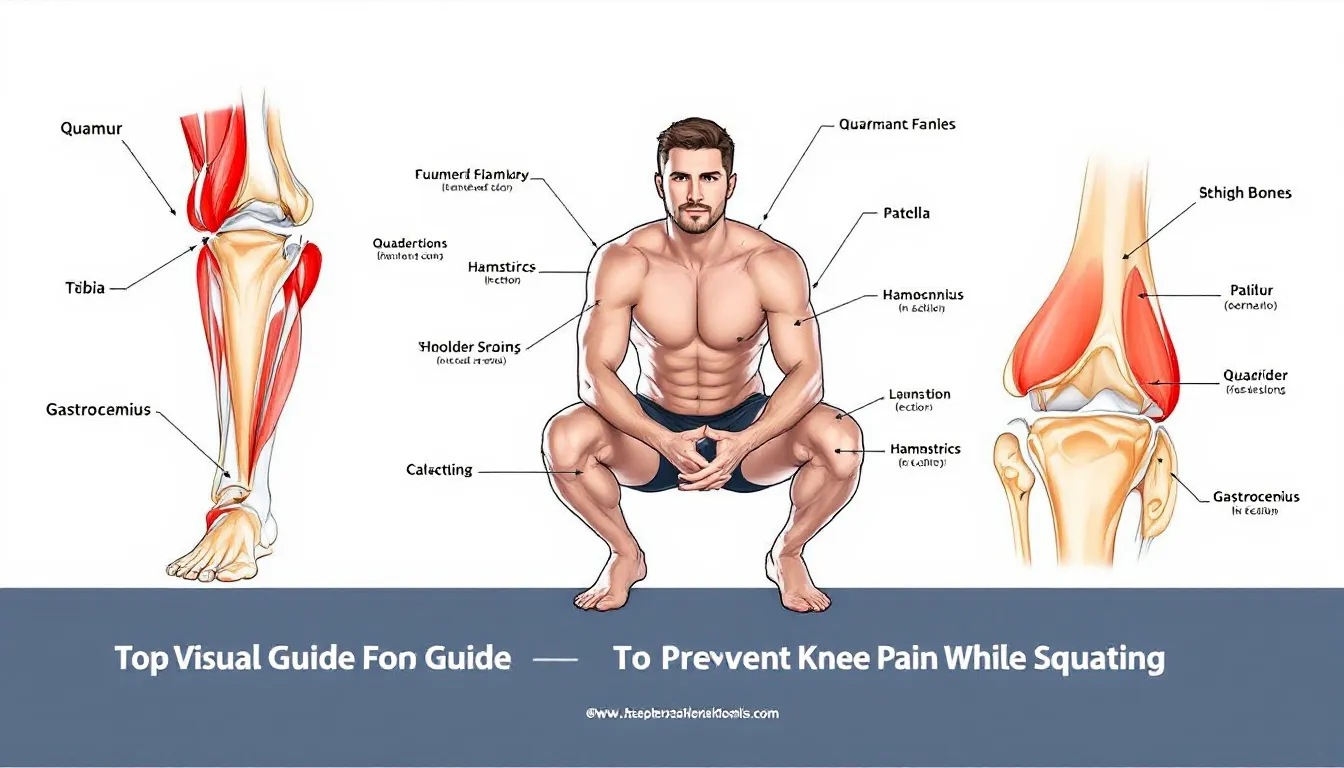Experiencing knee pain when squatting? You’re not alone. This article explains why your knees hurt during squats and offers practical solutions to relieve and prevent the pain.
Key Takeaways
- Knee pain during squats can be caused by incorrect form, muscle imbalances, or previous injuries.
- It requires proper diagnosis to prevent long-term damage.
- Effective treatment options include the RICE method, strengthening exercises, and physical therapy.
- Preventative measures like proper warm-up, correct squat techniques, and gradual progression in workout intensity helps to maintain knee health.
Understanding Knee Pain During Squats

You finally get into a workout groove, feeling stronger every week, and then out of nowhere, your knees start protesting every squat. Sound familiar?
Research has shown that the prevalence of knee pain is 27% in squatters. This means that for every 10 squatters, around 3 will have knee pain. So you aren’t alone.
But if your knees hurt when you squat, it’s usually a sign that something’s not quite right under the surface. It could be a muscle imbalance, poor alignment, or simply doing too much too soon.
Common signs include sharp knee pain, severe pain, dull aches, swelling, stiffness, and instability. These symptoms can be discouraging, especially when you’re eager to push your limits in the gym.
There are various causes of knee pain, they include
- Incorrect squat form
- Knee injuries,
- Specific knee conditions.
However, squats themselves are not inherently harmful to your knees. Being able to tell what kind of pain you’re feeling, can help you figure out what’s causing it and how to fix it. You can then take steps to relieve knee pain and ensure that your workouts remain safe and effective.
Common Causes of Knee Pain When Squatting

Knee pain during squats can be attributed to several factors. Each contributes to discomfort in different ways. Here are some common causes to consider:
- Incorrect squat form
- Weak or imbalanced muscles
- Tight muscles or tendons
- Previous injuries
- Specific medical conditions (e.g., arthritis)
Knowing what’s behind the pain is the first step to treating it properly. It also helps you ensure it doesn’t come back.
Common causes of knee pain when squatting include the following
Incorrect Squat Form
One of the most prevalent causes of knee pain while squatting is improper form.
Many gym-goers don’t even realise they’re doing squats incorrectly, until knee pain forces them to take a break.
One client we worked with thought they were doing everything right. But just tweaking knee alignment made a world of difference. When you bend your knees incorrectly, it places excessive pressure on the joint instead of distributing the load across the thigh muscles and glutes. This misalignment can lead to significant knee strain. It can also aggravate knee pain during and after squats.
Proper knee alignment and stance helps you squat correctly. Your knees should align with your toes. Additionally, your posture should prevent the knees from caving inward while keeping your knees forward.
Focusing on these key points reduces the risk of knee pain and ensures a safer, more effective workout.
Patellofemoral Pain Syndrome (Runner’s Knee)
In a systematic review of studies from 2018, researchers found that “the annual prevalence of patellofemoral pain in the general population was reported as 22.7%.”
Patellofemoral pain syndrome, often referred to as runner’s knee, is characterized by a dull ache around the knee cap. This pain worsens with activities like squatting. Patellofemoral pain syndrome is commonly caused by the wear and tear of cartilage on the knee cap, which increases pain during squats.
Typically, misalignment of the knee cap is a significant factor in patellofemoral pain syndrome. It’s what causes noticeable discomfort during squats.
Some symptoms can include
- knee pain after a workout.
- Clicking sensations
- Redness, and tenderness around the kneecap.
However, with a proper form and supportive exercises, you can reduce pain caused by this misalignment.
Patellar Tendonitis
Patellar tendonitis, also known as jumper’s knee, is caused by stress on the patellar tendon due to repetitive movements and overuse. Research shows that, “as many as 45% of elite athletes in jumping sports like basketball and volleyball suffer from PT”
This condition leads to inflammation and tears in the patellar tendon. When this happens, you can feel sharp knee pain and soreness during squats. The constant force exerted on the patellar tendon from physical activities can aggravate knee pain.
You can manage this condition through rest, proper technique, and strengthening exercises to prevent a patellar tendon tear.
Meniscus Tears
Meniscus tears are a frequent injury to the knee.
In fact, meniscal injury is one of the most common sports injuries in day-to-day practice. They can lead to considerable pain while performing squats. This injury involves the tearing of knee cartilage and cartilage tears due to severe injury or sprain. One of the symptoms is a locking sensation in the knee. Additionally, there may be sharp pain.
A meniscus tear increases knee pressure, making squatting painful and difficult. You need medical intervention and rehabilitation to restore knee function and reduce the pain.
Iliotibial Band Syndrome (ITBS)
Iliotibial Band Syndrome (ITBS) is caused by tightness in the iliotibial band, a thick tissue running along the outer thigh that helps stabilize the knee. This tightness can cause discomfort, knee misalignment during squats, and muscle imbalance.
Individuals with ITBS may experience outer knee pain and a snapping sensation when squatting. However, proper stretching and strengthening knee exercises can help maintain proper alignment and prevent pain during activities.
Weak Glutes
Think of your glutes as your body’s shock absorbers. If they’re not doing their job, your knees end up taking the hit, especially during movements like squats.
Insufficient strength in the glute muscles can result in additional stress on the knees. This results in pain when squatting. Strengthening the glutes improves balanced muscle strength and helps to prevent knee pain.
One way to achieve this is through regular strength training exercises. An example like lateral band walks can help improve glute strength significantly. These exercises also enhance knee stability and reduce discomfort during squats.
Treatment Options for Knee Pain During Squats

Knee pain during squats doesn’t signal the end of your fitness journey. There are treatments to manage the pain. This includes rest, therapy, and strengthening exercises as part of the treatment plan. However, you must first identify the specific cause of the pain before developing an appropriate treatment plan.
Here are some common treatment options;
RICE Method
The RICE method—Rest, Ice, Compression, and Elevation—is effective in reducing knee pain. Ice therapy helps prevent swelling and inflammation, while rest and compression minimize strain on the knee.
Additionally, cutting back on anything that makes the pain worse, without becoming totally inactive, can go a long way toward helping your knees heal.
Medication
For chronic or severe knee pain, prescription medications may be necessary. Non-steroidal anti-inflammatory drugs (NSAIDs) are commonly used to reduce inflammation and relieve pain relievers.
These medications can be effective for many individuals with knee issues But it’s important to consult with a healthcare provider for a comprehensive pain management strategy.
Consulting a healthcare practitioner helps you get a tailored approach. This often considers the underlying causes of knee pain, medical history, and physical activity levels to create an effective pain management.
Additionally, working with a healthcare provider ensures the most appropriate and effective treatment for your knee pain.
Strengthening Exercises
Research has shown that “An 8-week foot-ankle muscle strengthening program decreased knee pain and enhanced physical function in individuals with KOA, presenting a potential to be clinically meaningful”.
Exercises such as wall squats and knee bends help strengthen the muscles around the knees. It also improves flexibility, balance, and posture. Typically, it takes 4–8 weeks of consistent exercise to fully strengthen the muscles and joints for knee pain relief.
Some steps you can take include correcting posture and strengthening the glutes and quadriceps.g. Moreover, elevating heels during squats can also help by increasing squat depth and improving knee range of motion. Selecting proper exercises and techniques ensures reduced knee pain while squatting.
Physical Therapy
If you have concerns about your knee pain, you should consult a physical therapist. A therapist can assess musculoskeletal issues and create customized exercises to address knee pain.
Additionally, personalized care and tailored recovery plans provided through physiotherapy can significantly improve recovery outcomes.
Through physiotherapy, you can expect to gradually regain strength and stability in your knees.
However, if the knee pain persists after adjusting your squat form, visiting a doctor to check for underlying issues is advisable.
Preventing Knee Pain When Squatting

Preventing knee pain during squats involves regular physical activity, proper warm-up, and correct squat technique. Taking these steps helps you address potential issues before they become problematic. It also helps maintain healthy knees and enjoy pain-free workouts.
Here are some key prevention strategies:
Proper Warm-Up
A proper warm-up prepares the knee joints and leg muscles for squatting and preventing injuries.
Dynamic stretches such as leg swings and knee circles are effective for this purpose.
If you avoid proper stretching before exercising, it increases the risk of IT Band Syndrome, which can lead to knee pain.
Correct Squat Technique
Incorrect squat form can strain the knees, leading to sharp pain or a sharper pain, or a dull ache. You should always aim for proper knee alignment. This ensures your knees do not cave inward and your feet remain shoulder-width apart. When you incorporate this into your workout routine, it reduces the risk of injury and improves performance.
Additionally, try not to rush your squats. That’s how injuries happen. Instead, think of it like climbing stairs, take it one step at a time and let your body catch up. Focusing on these key points reduces the risk of knee pain and ensures a safer, more effective workout.
Gradual Progression
Gradual progression in your squat workout routine helps in preventing knee injuries. You should begin with mini squats and slowly increase the range of motion and weight to reduce the risk of injury.
When you increase the squats incrementally, like adding more repetitions, you can avoid overuse injuries.
Summary
Knee pain during squats has various causes such as incorrect squat form, patellofemoral syndrome, patellar tendonitis, meniscus tears, iliotibial band syndrome, and weak glutes. Understanding these causes helps you decide on an effective treatment and prevention. But beyond treatment, you can take steps to address the root cause before it becomes a problem.
This can include taking proactive measures such as proper warm-up, correct squat technique, and gradual progression to significantly reduce the risk of knee pain. With the right combination of treatment and prevention strategies, you can enjoy pain-free squats and maintain healthy knees.
Remember, knee pain doesn’t mean you have to quit squatting altogether. It just means your body’s asking for a different approach. Listen to it, adjust, and you’ll come back even stronger.
Need help with your Knee pain?
Book a functional massage session today.
Frequently Asked Questions
What are the common causes of knee pain when squatting?
Knee pain during squatting is often caused by incorrect form, patellofemoral pain syndrome, patellar tendonitis, meniscus tears, iliotibial band syndrome, and weak glute muscles.
How can I prevent knee pain during squats?
To prevent knee pain during squats, ensure you warm up adequately, maintain proper form, and increase intensity and weight gradually.
What is the RICE method, and how does it help with knee pain?
The RICE method – Rest, Ice, Compression, and Elevation – effectively alleviates knee pain by reducing strain and swelling while promoting healing. Implementing this approach can significantly enhance your recovery process.
Are there specific exercises that can help reduce knee pain when squatting?
Incorporating strengthening exercises like wall squats, knee bends, and high-heel squats can significantly improve knee stability and alleviate pain during squatting.
When should I see a doctor for knee pain during squats?
If your knee pain continues despite rest and self-care, it’s essential to see a doctor for a thorough evaluation and personalized treatment plan. Don’t ignore persistent pain, as addressing it early can prevent further complications.
